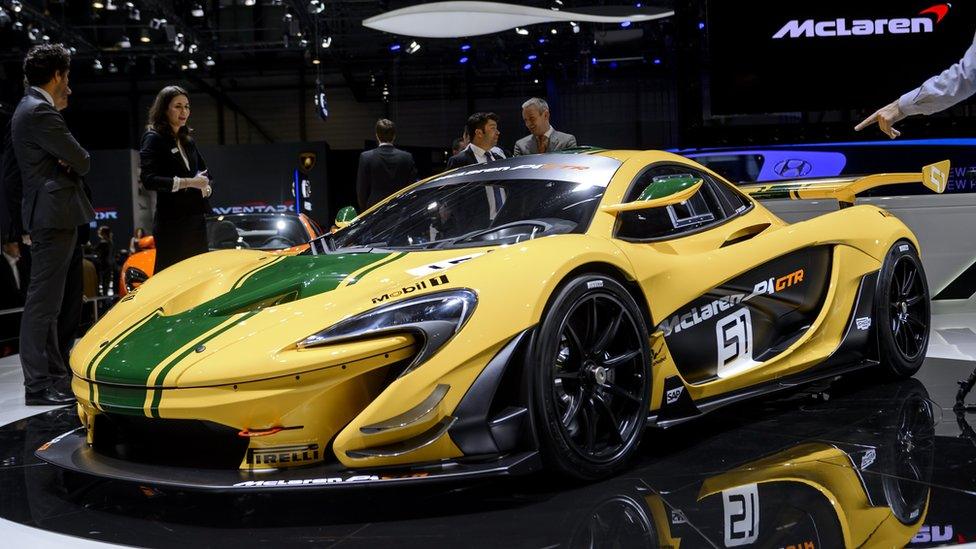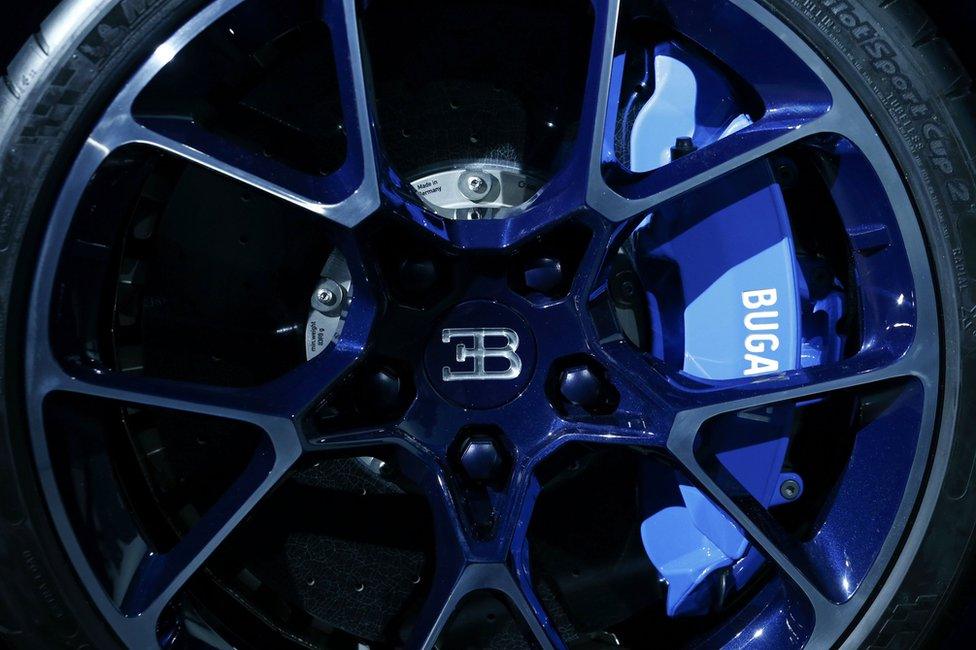How can you improve upon 'automotive perfection'?
- Published

The Chiron has 1,500 brake horsepower and a limited top speed of 261mph (420km/h)
How do you improve on something many experts thought was faultless?
Bugatti's Veyron supercar was considered an auto-engineering masterpiece; not just carmaking, but science.
Then someone at Bugatti's owner Volkswagen decided that they should try to do better.
The result is the Chiron, unveiled at this week's Geneva Motor Show to the sort of adulation and hyperbole that greeted its predecessor 10 years ago.
While environmentalists weep, petrolheads rejoice - the world now has a new fastest production car.
"The challenge was to be better than the previous car in every dimension," company president Wolfgang Durheimer tells the BBC.
Bugatti unveils its Chiron supercar at this year's Geneva Motor Show
At €2.4m (£1.86m; $2.6m) each - plus taxes and delivery - the Chiron is nearly twice the price of the Veyron.
"My brief for this car was the shortest I ever had in my career. It was four words: Just do the best," he says.
Power boost
With 1,500 horsepower and a top speed of 261mph (420km/h) the Chiron is 3mph faster than the Veyron. The Chiron, though, has a speed limiter. Without it, it could reach 285-287mph, Bugatti says.
The car can do 0-62mph in fractionally under 2.5 seconds, although there is no official figure yet as more speed tests are planned.

Who was Louis Chiron?

Racing driver Louis Chiron became synonymous with Bugatti
Born 3 August 1899, Monte Carlo, Monaco; died 22 June 1979
Racing driver who won many races and grands prix for Bugatti in the 1920s-30s
The only Monaco-born person - Monegasque - to win the Monaco Grand Prix, in 1931
For races he always wore a lucky red scarf with white spots
He was still competing in Formula 1 races at the age of 55
Chiron also drove for Ferrari, Maserati and Mercedes-Benz amongst other teams

The car is lighter, but also wider and longer - only by millimetres, but that's a radical change in size for a design engineer trying to maximise performance.
"The engine is more lightweight than the Veyron. But it has more power. And I don't mean just a little bit more power," says Mr Durheimer.
"We increased the engine by 300 horsepower. This is the power of a standard road car. We achieved that order of increase."

Like the Veyron, the Chiron has an eight-litre W16 engine - four banks of four cylinders - but has received a power boost of 25% compared with its predecessor.
But this 25% increase in power doesn't translate into a 25% increase in speed. This is because at very high speeds wind resistance increases significantly, explains Professor Will Stewart of the Institution of Engineering and Technology.
"To go twice as fast you need eight times the power," he says.
So greater use of lightweight titanium and carbon fibre materials helped increase the Chiron's power-to-weight ratio.

The luxury supercar will set you back £1.86m
"I think that every single component on the car was re-developed or considered for re-development," says Mr Durheimer.
The single biggest challenge was how to package all that power and technology into something that also looked like a Bugatti and was comfortable to drive, says Mr Durheimer.
Taming the wind
"A supercar is basically flat on the bottom and curved on top, so air going over the top goes faster, creating lift - the Bernoulli effect," says Prof Stewart.
"But you don't want lift, so you put a big aerofoil on the back to keep the car on the road. But that creates drag - the enemy of speed."

One of the key challenges for supercars is managing airflow at very high speeds
So to meet these challenges, Bugatti has created an all-new chassis suspension system, which adjusts depending on the driving conditions.
There are five modes, working in tandem with various aero-stability features - flaps, spoilers, diffusers - all designed to makes the Chiron glide through the air more efficiently and cool the engine and brakes.
Even the rear spoiler is dynamic, automatically adjusting its position to suit the driving conditions.

McLaren's cars are also at the technological cutting edge
The car also needed a new cooling system to dissipate the extra engine heat. The Chiron has 10 radiators, and pumps that circulate 60,000 litres of air and 800 litres of water through the engine each minute.
If one feature gets too much "freedom" the final product becomes unbalanced, says Mr Durheimer. And yet, "if you want to be the best, you also cannot compromise."
Getting a grip
The Chiron's greater power and speed meant building a new braking system.
The front and rear brake discs are now 20mm larger and 2mm thicker. But, being made of carbon-silicon material, they weigh less.
The discs are gripped by lighter titanium piston callipers, eight at the front and six at the rear.
And the tyres had to be redeveloped, too

The Chiron's brake discs are thicker and wider, but lighter than the Veyron's
"It was another big challenge. All the energy performance connects to the road through the tyres. We knew that if we wanted to go faster we needed a completely new tyre," Mr Durheimer says.
Michelin, which had pushed the boundaries of tyre technology for the Veyron, was brought in to work on the Chiron.
Neither Michelin, nor any carmaker, had facilities to put the tyres through the necessary endurance and safety tests.
"We had to use aircraft test benches to monitor performance," Mr Durheimer says. The result is a tyre 14% wider at the front, and 12% at the back, offering better braking, acceleration and wet-weather grip.
What's the point?
After VW's diesel emissions scandal last year and subsequent cost-cutting, there were reports that the Chiron project might be canned.
But Mr Durheimer says this was never on the cards, especially as "dieselgate" broke when the Chiron's development was already far down the line.
Even so, he had to draw up a business plan showing that the Chiron, based on sales capped at 500, would make a profit - unlike, it is widely reported, the Veyron.

Will mega-rich Chiron owners ever be able to test the car to its limits?
"A serious business does not sack a project that is going to make a positive overall contribution to the business," he says.
Prior to the Geneva show, 170 Chirons had been sold, with the first batch due to be delivered this autumn. Several are delivered at a time, so no one can claim "I was the first".
But where can these mega-rich owners legally and safely test such a car to its limits?
"There's nothing theoretically difficult about going faster," says Prof Stewart, "but it's our ability to control a vehicle at those speeds that is the issue. In an emergency, it might be better to hand over control to an onboard computer."
But for the the auto-engineer, the joy is having the freedom to push the boundaries, Mr Durheimer says.
"It is part of human nature to cross boundaries and set new records… to fly even further into space and to enter new realms.
"The Chiron is the result of our efforts to make the best even better."

Follow Technology of Business editor @matthew_wall, external on Twitter.
